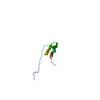+ Open data
Open data
- Basic information
Basic information
| Entry | Database: PDB / ID: 1j8i | ||||||
|---|---|---|---|---|---|---|---|
| Title | Solution Structure of Human Lymphotactin | ||||||
 Components Components | Lymphotactin XCL1 XCL1 | ||||||
 Keywords Keywords |  CYTOKINE / CYTOKINE /  Chemokine Chemokine | ||||||
| Function / homology |  Function and homology information Function and homology informationmature natural killer cell chemotaxis / positive regulation of granzyme A production / negative regulation of T-helper 1 cell activation / positive regulation of immunoglobulin production in mucosal tissue / positive regulation of thymocyte migration / positive regulation of granzyme B production / negative regulation of T-helper 1 type immune response / positive regulation of B cell chemotaxis / negative regulation of T cell cytokine production / positive regulation of natural killer cell chemotaxis ...mature natural killer cell chemotaxis / positive regulation of granzyme A production / negative regulation of T-helper 1 cell activation / positive regulation of immunoglobulin production in mucosal tissue / positive regulation of thymocyte migration / positive regulation of granzyme B production / negative regulation of T-helper 1 type immune response / positive regulation of B cell chemotaxis / negative regulation of T cell cytokine production / positive regulation of natural killer cell chemotaxis /  chemokine receptor binding / positive regulation of T-helper 1 cell cytokine production / positive regulation of transforming growth factor beta production / positive regulation of T cell chemotaxis / positive regulation of T-helper 2 cell cytokine production / CCR chemokine receptor binding / lymphocyte chemotaxis / positive regulation of CD4-positive, alpha-beta T cell proliferation / negative regulation of CD4-positive, alpha-beta T cell proliferation / eosinophil chemotaxis / chemokine-mediated signaling pathway / positive regulation of neutrophil chemotaxis / Chemokine receptors bind chemokines / chemokine receptor binding / positive regulation of T-helper 1 cell cytokine production / positive regulation of transforming growth factor beta production / positive regulation of T cell chemotaxis / positive regulation of T-helper 2 cell cytokine production / CCR chemokine receptor binding / lymphocyte chemotaxis / positive regulation of CD4-positive, alpha-beta T cell proliferation / negative regulation of CD4-positive, alpha-beta T cell proliferation / eosinophil chemotaxis / chemokine-mediated signaling pathway / positive regulation of neutrophil chemotaxis / Chemokine receptors bind chemokines /  chemokine activity / positive regulation of leukocyte chemotaxis / negative regulation of interleukin-2 production / positive regulation of CD8-positive, alpha-beta T cell proliferation / monocyte chemotaxis / positive regulation of interleukin-10 production / negative regulation of type II interferon production / cellular response to interleukin-1 / cellular response to interleukin-4 / release of sequestered calcium ion into cytosol / cellular response to transforming growth factor beta stimulus / chemokine activity / positive regulation of leukocyte chemotaxis / negative regulation of interleukin-2 production / positive regulation of CD8-positive, alpha-beta T cell proliferation / monocyte chemotaxis / positive regulation of interleukin-10 production / negative regulation of type II interferon production / cellular response to interleukin-1 / cellular response to interleukin-4 / release of sequestered calcium ion into cytosol / cellular response to transforming growth factor beta stimulus /  neutrophil chemotaxis / positive regulation of release of sequestered calcium ion into cytosol / response to virus / negative regulation of DNA-binding transcription factor activity / positive regulation of T cell cytokine production / cellular response to type II interferon / positive regulation of T cell mediated cytotoxicity / cell-cell signaling / cellular response to tumor necrosis factor / neutrophil chemotaxis / positive regulation of release of sequestered calcium ion into cytosol / response to virus / negative regulation of DNA-binding transcription factor activity / positive regulation of T cell cytokine production / cellular response to type II interferon / positive regulation of T cell mediated cytotoxicity / cell-cell signaling / cellular response to tumor necrosis factor /  regulation of inflammatory response / G alpha (q) signalling events / positive regulation of ERK1 and ERK2 cascade / regulation of inflammatory response / G alpha (q) signalling events / positive regulation of ERK1 and ERK2 cascade /  inflammatory response / G protein-coupled receptor signaling pathway / negative regulation of DNA-templated transcription / inflammatory response / G protein-coupled receptor signaling pathway / negative regulation of DNA-templated transcription /  signal transduction / protein homodimerization activity / signal transduction / protein homodimerization activity /  extracellular space / extracellular region extracellular space / extracellular regionSimilarity search - Function | ||||||
| Biological species |   Homo sapiens (human) Homo sapiens (human) | ||||||
| Method |  SOLUTION NMR / torsion angle dynamics SOLUTION NMR / torsion angle dynamics | ||||||
 Authors Authors | Kuloglu, E.S. / McCaslin, D.R. / Markley, J.L. / Pauza, C.D. / Volkman, B.F. | ||||||
 Citation Citation |  Journal: Biochemistry / Year: 2001 Journal: Biochemistry / Year: 2001Title: Monomeric solution structure of the prototypical 'C' chemokine lymphotactin. Authors: Kuloglu, E.S. / McCaslin, D.R. / Kitabwalla, M. / Pauza, C.D. / Markley, J.L. / Volkman, B.F. | ||||||
| History |
|
- Structure visualization
Structure visualization
| Structure viewer | Molecule:  Molmil Molmil Jmol/JSmol Jmol/JSmol |
|---|
- Downloads & links
Downloads & links
- Download
Download
| PDBx/mmCIF format |  1j8i.cif.gz 1j8i.cif.gz | 569.6 KB | Display |  PDBx/mmCIF format PDBx/mmCIF format |
|---|---|---|---|---|
| PDB format |  pdb1j8i.ent.gz pdb1j8i.ent.gz | 493 KB | Display |  PDB format PDB format |
| PDBx/mmJSON format |  1j8i.json.gz 1j8i.json.gz | Tree view |  PDBx/mmJSON format PDBx/mmJSON format | |
| Others |  Other downloads Other downloads |
-Validation report
| Arichive directory |  https://data.pdbj.org/pub/pdb/validation_reports/j8/1j8i https://data.pdbj.org/pub/pdb/validation_reports/j8/1j8i ftp://data.pdbj.org/pub/pdb/validation_reports/j8/1j8i ftp://data.pdbj.org/pub/pdb/validation_reports/j8/1j8i | HTTPS FTP |
|---|
-Related structure data
- Links
Links
- Assembly
Assembly
| Deposited unit | 
| |||||||||
|---|---|---|---|---|---|---|---|---|---|---|
| 1 |
| |||||||||
| NMR ensembles |
|
- Components
Components
| #1: Protein |  XCL1 XCL1Mass: 10286.789 Da / Num. of mol.: 1 Source method: isolated from a genetically manipulated source Source: (gene. exp.)   Homo sapiens (human) / Plasmid: pET3A / Production host: Homo sapiens (human) / Plasmid: pET3A / Production host:   Escherichia coli (E. coli) / Strain (production host): BL21(DE3)pLysS / References: UniProt: P47992 Escherichia coli (E. coli) / Strain (production host): BL21(DE3)pLysS / References: UniProt: P47992 |
|---|
-Experimental details
-Experiment
| Experiment | Method:  SOLUTION NMR SOLUTION NMR | ||||||||||||||||
|---|---|---|---|---|---|---|---|---|---|---|---|---|---|---|---|---|---|
| NMR experiment |
| ||||||||||||||||
| NMR details | Text: The structure was determined using triple-resonance NMR spectroscopy. |
- Sample preparation
Sample preparation
| Details |
| ||||||||||||
|---|---|---|---|---|---|---|---|---|---|---|---|---|---|
| Sample conditions | Ionic strength: 200 mM sodium chloride / pH: 6.0 / Temperature: 283 K |
-NMR measurement
| Radiation | Protocol: SINGLE WAVELENGTH / Monochromatic (M) / Laue (L): M | |||||||||||||||
|---|---|---|---|---|---|---|---|---|---|---|---|---|---|---|---|---|
| Radiation wavelength | Relative weight: 1 | |||||||||||||||
| NMR spectrometer |
|
- Processing
Processing
| NMR software |
| ||||||||||||||||||||||||||||
|---|---|---|---|---|---|---|---|---|---|---|---|---|---|---|---|---|---|---|---|---|---|---|---|---|---|---|---|---|---|
| Refinement | Method: torsion angle dynamics / Software ordinal: 1 Details: The structures are based on a total of 1258 NOE-derived distance constraints, 60 dihedral angle constraints and 4 disulfide bond constraints. | ||||||||||||||||||||||||||||
| NMR ensemble | Conformer selection criteria: structures with the lowest energy, target function Conformers calculated total number: 50 / Conformers submitted total number: 20 |
 Movie
Movie Controller
Controller












 PDBj
PDBj
